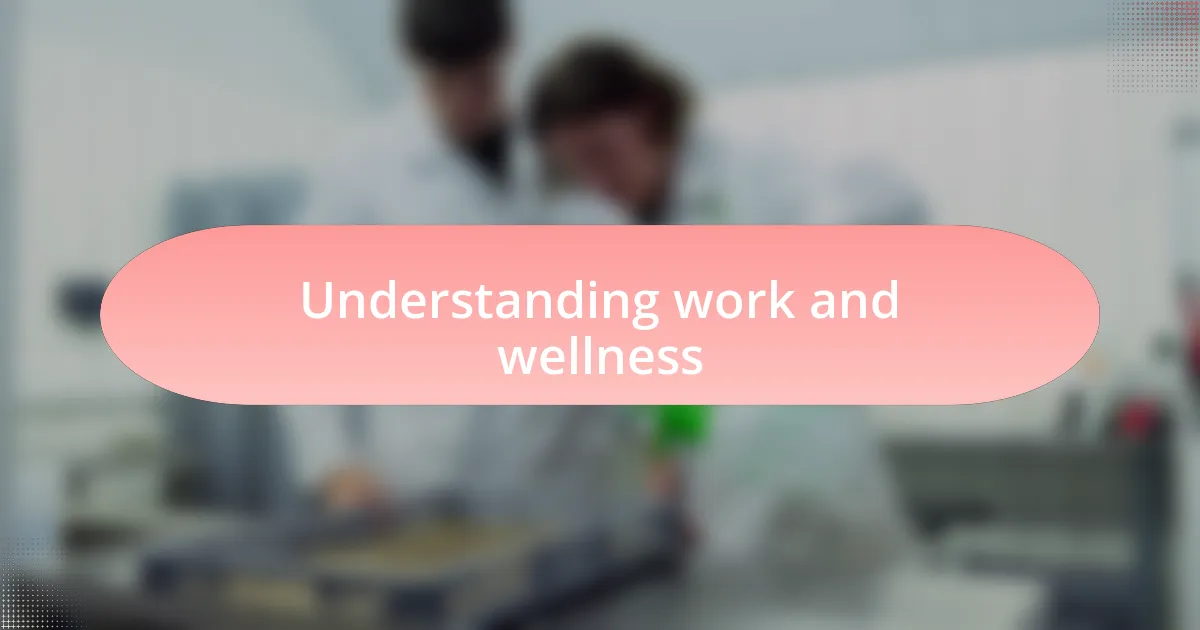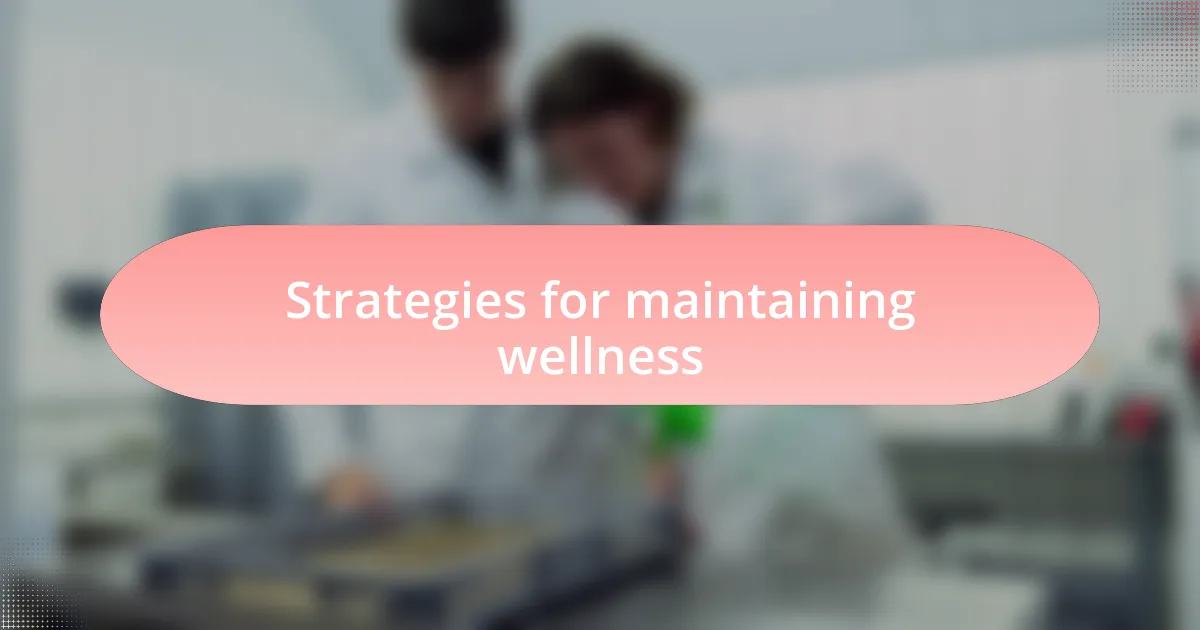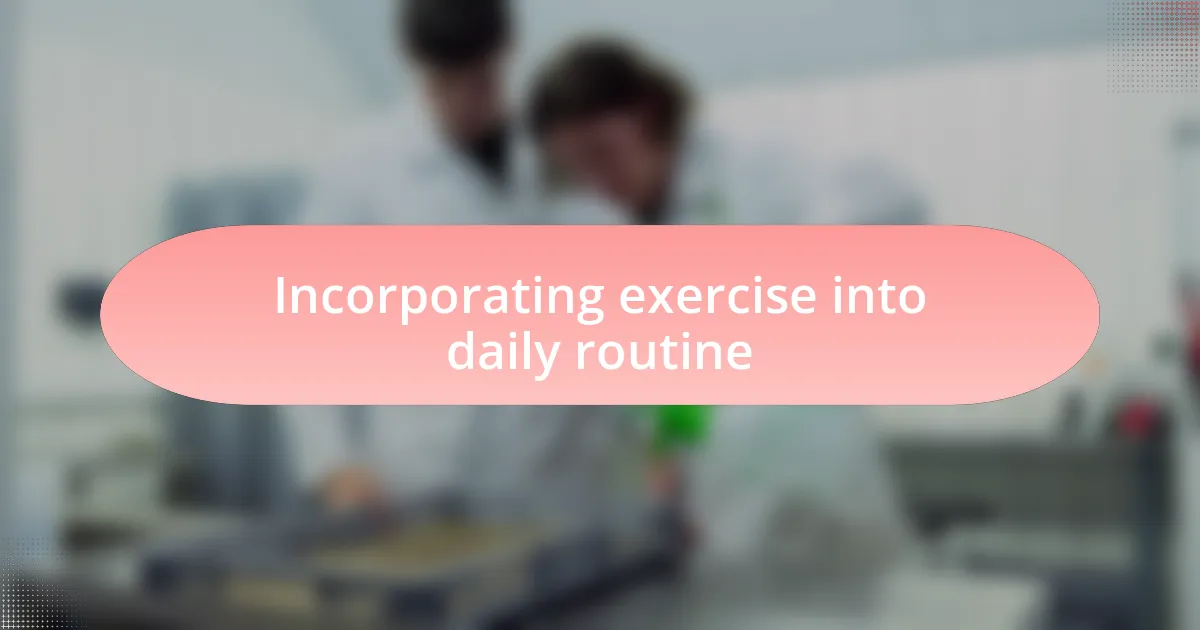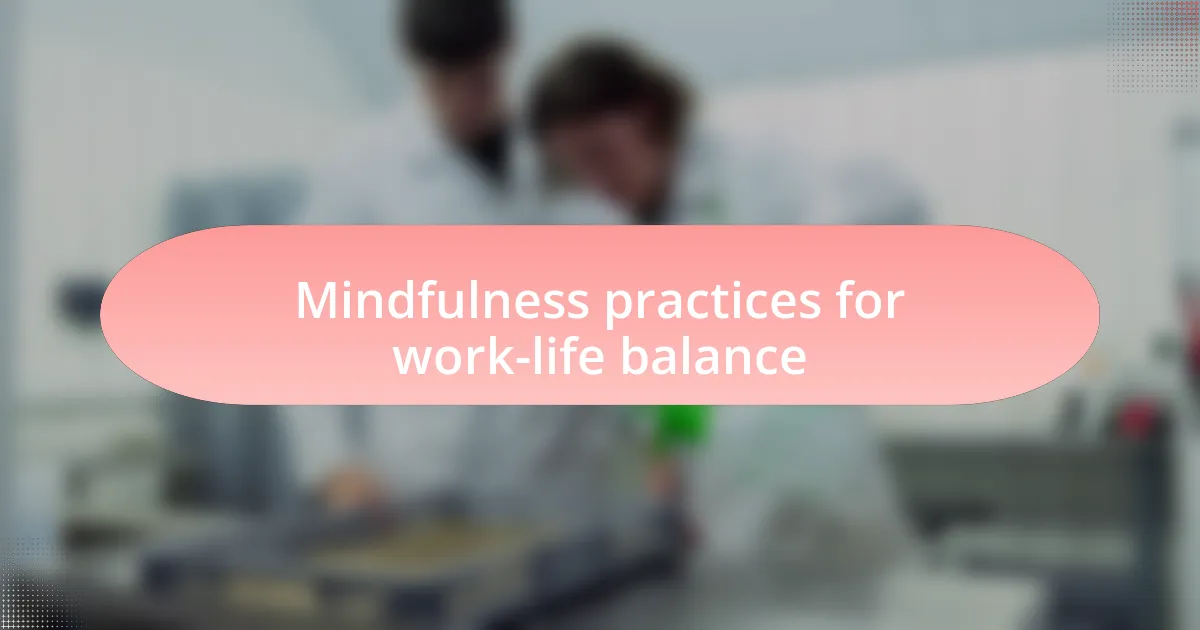Key takeaways:
- Work and wellness are closely interconnected, with mental and physical health significantly influencing productivity and engagement.
- A balanced approach to work-life balance enhances creativity, resilience, and personal fulfillment, proving essential for overall well-being.
- Effective stress management and mindfulness practices, such as deep breathing and regular breaks, contribute to better health and work performance.
- Incorporating physical activity into daily routines, even in small ways, can improve mood and productivity amidst busy schedules.

Understanding work and wellness
Work and wellness are intricately linked, forming a delicate balance that can significantly impact our overall quality of life. I remember a time when work demands seemed insurmountable, and I often felt overwhelmed. It struck me how crucial it is to recognize that our mental and physical well-being directly affects our productivity and engagement at work.
Think about it: when was the last time you felt your best while grappling with a heavy workload? For me, it was during a particularly stressful project when I chose to prioritize my mental health with regular breaks and mindfulness practices. This simple shift made a world of difference in sustaining my focus and energy, reinforcing the idea that nurturing our well-being is not just beneficial—it’s essential for success.
Understanding the interplay of work and wellness prompts us to ask ourselves meaningful questions: Are we truly happy in our careers? Are we taking the necessary steps to maintain our health amidst our professional responsibilities? Reflecting on these questions can inspire actions that cultivate a healthier work-life balance, creating a foundation for both personal fulfillment and professional achievement.

Importance of work-life balance
Work-life balance is not just a buzzword; it’s a vital component for maintaining overall health. I recall a period in my career when I worked late into the night, convinced that more hours equated to higher productivity. The toll on my mental health was profound, and I realized that without balance, I was merely spinning my wheels rather than making meaningful progress.
Have you ever felt like your personal life is slipping away while you’re glued to your work? I certainly have. One evening, after missing yet another family dinner due to work commitments, I took a step back and reassessed my priorities. Recognizing that time with loved ones nourishes my soul was a game-changer, reinforcing my belief that work should enhance our lives, not consume them.
Embracing a balanced approach allows us not only to recharge but also to foster creativity and resilience in our work. I have found that taking time off for hobbies—like painting or hiking—ignites new ideas and perspectives, enhancing my professional contributions. This cyclical relationship between rest and productivity illustrates that prioritizing wellness can transform our work into a source of joy rather than a source of stress.

Impact of stress on health
The impact of stress on health can be both immediate and long-lasting. I remember a time I was under constant pressure at work, my mind racing and my body always tense. I developed headaches and sleepless nights, revealing just how intertwined stress is with our physical and mental well-being.
Stress doesn’t just affect how we feel; it can lead to serious health problems over time. For instance, I once ignored my pounding heart, attributing it merely to a hectic schedule. Eventually, a visit to the doctor revealed early signs of hypertension. This was a wake-up call about how my work mentality was silently sabotaging my health.
Have you ever noticed how your stress levels can influence your immune system? I certainly did when I found myself frequently catching colds during particularly busy work periods. It’s as if stress actively worked against my body, showcasing the necessity of managing both mental and physical health to truly thrive in our daily lives.

Strategies for maintaining wellness
Finding ways to integrate wellness into my busy schedule has been essential for me. One strategy I’ve found particularly helpful is setting specific, non-negotiable times for physical activity, even if it’s just a quick 15-minute walk. I’ve realized that movement not only energizes my body but also clears my mind, letting me tackle challenges with a fresh perspective.
I also prioritize mindfulness practices, such as meditation or deep breathing exercises. These routines help ground me during the day, especially when work pressures mount. I vividly remember a hectic week filled with deadlines when taking just five minutes to focus on my breath made a noticeable difference in how I handled stress.
Nutrition plays a crucial role in my wellness strategy, too. I started meal prepping to ensure that I have healthy, nourishing options readily available. It’s remarkable how fueling my body with the right foods positively impacts my energy levels and overall mood. Have you ever noticed how what you eat directly influences your mental clarity? For me, choosing whole foods over processed snacks has transformed my approach to both work and personal well-being.

Incorporating exercise into daily routine
Incorporating exercise into my daily routine often feels like a tightrope walk, but I’ve found it immensely rewarding. One simple adjustment has been to choose walking meetings when possible. I can’t tell you how refreshing it is to chat with colleagues while strolling outside; not only does it boost our creativity, but I also feel physically invigorated.
Then there are those days when I struggle to find time for a full workout. On those occasions, I rely on short bursts of activity, like doing a few sets of push-ups or taking the stairs instead of the elevator. I remember one particularly busy afternoon when I snuck in a quick five-minute bodyweight routine between meetings, and I felt a significant lift in my mood. Is it just me, or does a little movement go a long way in recharging our focus?
Another approach that works well for me is to incorporate exercise into daily chores. For instance, I’ve turned my laundry routine into a mini workout by adding in some squats while waiting for the dryer. It’s fascinating how these little tweaks not only help me stay active but also make mundane tasks feel more enjoyable. Have you ever tried to make a chore feel less like a chore? It’s freeing to realize that movement can fit seamlessly into my everyday life.

Mindfulness practices for work-life balance
Mindfulness has become an essential tool for me in managing both work and personal life effectively. I’ve discovered that taking just five minutes each morning to practice deep breathing can set a positive tone for my entire day. There were times when I felt overwhelmed by deadlines; simply pausing to breathe deeply helped me regain clarity and focus. Have you ever noticed how just a brief moment of stillness can change your perspective?
Incorporating mindfulness meditation into my daily routine has also proven to be incredibly beneficial. I often sit quietly in the afternoon for a short session, allowing myself to let go of stress from the morning. One memorable experience was during a particularly hectic week; after just ten minutes of meditation, I returned to my work feeling recharged and ready to tackle challenges. Doesn’t it feel great to give your mind a little reset in the middle of a busy day?
Another practice I swear by is a mindful walk during lunch. I relish those moments where I can step away from my desk, appreciate nature, and clear my mind. One day, I found a charming park nearby and took my break there—it was transformative. Suddenly, I wasn’t just taking a break; I was actively engaging with my surroundings. Have you found an opportunity to connect with the world around you lately? The moments of mindfulness I carve out not only help me be more present but also inspire creativity and a deeper connection with my work.